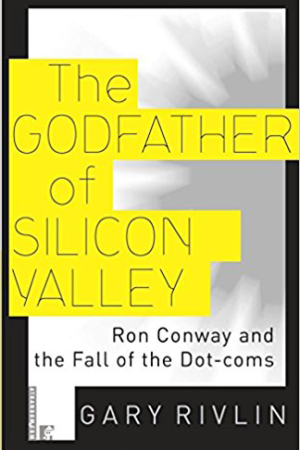The Godfather Of Silicon Valley
Ron Conway and the Fall of the Dot-coms
- The Godfather Of Silicon Valley
- Praise
-
I had what I thought was this swell idea: delve deep into the life of a man named Ron Conway to tell the wider tale of the dot-com rise and fall. The story of the Internet through the second half of the 1990s writ small, as told through this guy who had slapped down more bets on Internet startups than anyone else in Silicon Valley, 240, in less than three years’ time.
Conway, a former salesman who had made a bundle in the computer business, knew next to nothing about technology. An assistant would print out an e-mail message so he could then read it and hand scribble a reply that she would then type in. Yet he had a gift for networking, and quickly some of the Valley’s better-connected entrepreneurs pegged him as an easy touch. A web site to supply vet med supplies; a weight-loss site; a maternity site; an e-commerce company featuring a search engine that sussed out a buyer’s mood: a good many of Conway’s investments called to mind the Calvin & Hobbes cartoon in which Calvin, with a bursting water balloon in hand, says, “How can something seem so plausible at the time and so idiotic in retrospect.”
Sweetening the story was that Conway invested not only millions of his own money but invested large sums on behalf of the rich and fabulous, including stars in the tech world like Bill Joy and Esther Dyson but also Shaquille O’Neal, Arnold Schwarzenegger, Tiger Woods, and Henry Kissinger. He also had impeccably poor timing: he had decided to go for the gold ring, raising $150 million, shortly before the Nasdaq went into the paroxysms of its great fall. “I love disaster,” the band Television sang, “I love what comes after.”
The problem—well, let’s just say the book was as star-crossed as Conway’s scheme to get rich off the Internet. For starters the book began life as one of the book publishing world’s earliest e-books (it was simultaneously released as a paperback)–and a few weeks prior to its release The New York Times ran a page-one piece declaring the e-book one of the dot-com era’s more idiotic innovations. The pub date assigned the book was Sept. 11, 2001 – which would turn out to be about the worst pub date imaginable. Newsweek was set to run an excerpt a couple of weeks later. I didn’t even bother calling my editor there to confirm the obvious. There’d be no room in the magazine for a light-hearted look at the failed investments of a bunch of rich celebrities and tech impressarios.
The book got a nice review in Sunday New York Times. The reviewer, Rob Walker, wondered why anyone might care about the dot-com collapse in light of far more pressing, weighty matters, but he allowed that I did a nice job in telling my story. Similarly, the San Jose Mercury News’ Dan Lee wrote that I tell a “rich and detailed” story and manage to “capture the brief period of madness between 1998 and 2001” in a slim, 103-page book. But mainly the book brought to mind that eternal question of whether a book that falls isolated in the forest makes any noise.
-
“Rivlin’s sharp eye for physical detail is matched by his ear for the spin and gibberish that permeate the software industry.”
The Baltimore Sun“Rivlin is a resourceful reporter, a passionate writer and a marvelous storyteller who offers a fresh and exciting look at today’s cyber-barons.”
Clarence Page, Pulitzer Prize-winning columnist


